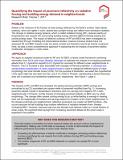| dc.contributor.author | Xu, Xin | |
| dc.contributor.author | Gregory, Jeremy | |
| dc.contributor.author | Kirchain, Randolph | |
| dc.date.accessioned | 2017-03-13T19:18:51Z | |
| dc.date.available | 2017-03-13T19:18:51Z | |
| dc.date.issued | 2017-03-13 | |
| dc.identifier.uri | http://hdl.handle.net/1721.1/107404 | |
| dc.description.abstract | Albedo is the measure of the fraction of solar energy reflected by the Earth’s surface. High-albedo surfaces, which are lighter in color, absorb less sunlight energy and reflect more shortwave radiation. The change in radiative energy balance, which is called radiative forcing (RF), reduces nearby air temperatures and impacts the surrounding building energy demand (BED) including heating and cooling energy loads. The impact of reflective surfaces on RF and BED has been investigated by researchers through modeling and observational studies, however previous studies have not assessed RF and BED impacts under the same context and therefore cannot be directly compared. Here, we take a more comprehensive approach in assessing the net impacts of pavement albedo modification strategies in urban areas. | en_US |
| dc.description.sponsorship | Sponsorship provided by the Portland Cement Association and the Ready Mixed Concrete Research & Education Foundation. | en_US |
| dc.relation.ispartofseries | ;vol 1, 2017 | |
| dc.subject | Quantifying the impact of pavement reflectivity on radiative forcing and building energy demand in neighborhoods | en_US |
| dc.subject | albedo | en_US |
| dc.subject | surface albedo | en_US |
| dc.subject | Pavement | en_US |
| dc.subject | Buildings | en_US |
| dc.subject | Neighborhood | en_US |
| dc.subject | Environmental Performance | en_US |
| dc.subject | Surface reflectivity | en_US |
| dc.subject | Building energy demand | en_US |
| dc.subject | radiative forcing | en_US |
| dc.title | Research Brief: Quantifying the impact of pavement reflectivity on radiative forcing and building energy demand in neighborhoods | en_US |
